
Liguria is a region of north-western Italy; its capital is Genoa. Its territory is crossed by the Alps and the Apennines mountain range and is roughly coextensive with the former territory of the Republic of Genoa. Liguria is bordered by France to the west, Piedmont to the north, and Emilia-Romagna and Tuscany to the east. It rests on the Ligurian Sea, and has a population of 1,557,533. The region is part of the Alps–Mediterranean Euroregion.
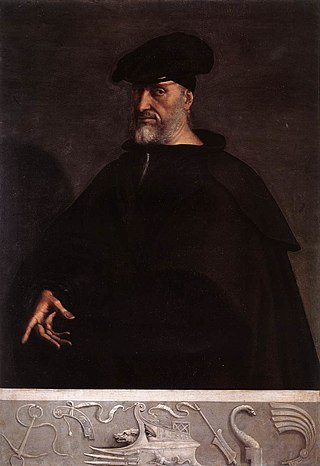
Andrea Doria, Prince of Melfi was a Genoese statesman, condottiero, and admiral, who played a key role in the Republic of Genoa during his lifetime.

The Doge of Genoa was the head of state of the Republic of Genoa, a city-state and soon afterwards a maritime republic, from 1339 until the state's extinction in 1797. Originally elected for life, after 1528 the Doges were elected for terms of two years. The Republic was ruled by a small group of merchant families, from whom the doges were selected.

The Republic of Genoa was a medieval and early modern maritime republic from the years 1099 to 1797 in Liguria on the northwestern Italian coast. During the Late Middle Ages, it was a major commercial power in both the Mediterranean and Black Sea. Between the 16th and 17th centuries, it was one of the major financial centres in Europe.

The War of the Reunions (1683–84) was a conflict between France, Spain and the Holy Roman Empire, with limited involvement by Genoa. It can be seen as a continuation of the War of Devolution (1667–1668) and the Franco-Dutch War (1672–1678), which were driven by Louis XIV's determination to establish defensible boundaries along France's northern and eastern borders.
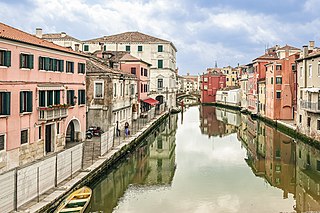
The War of Chioggia was a conflict fought by the Republic of Genoa against the Republic of Venice between 1378 and 1381, the conclusion of an open confrontation that had lasted for years and which had already included some occasional and limited military clashes.

The maritime republics, also called merchant republics, were Italian thalassocratic port cities which, starting from the Middle Ages, enjoyed political autonomy and economic prosperity brought about by their maritime activities. The term, coined during the 19th century, generally refers to four Italian cities, whose coats of arms have been shown since 1947 on the flags of the Italian Navy and the Italian Merchant Navy: Amalfi, Genoa, Pisa, and Venice. In addition to the four best known cities, Ancona, Gaeta, Noli, and, in Dalmatia, Ragusa, are also considered maritime republics; in certain historical periods, they had no secondary importance compared to some of the better known cities.

Genoa, Italy, has historically been one of the most important ports on the Mediterranean.
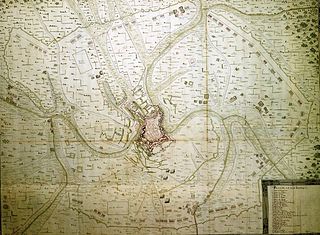
The siege of Luxembourg, in which Louis XIV of France laid siege to the Spanish-controlled Fortress of Luxembourg from 27 April to 7 June 1684, was the most significant confrontation of the War of the Reunions between France and Spain. The action caused alarm among France's neighbours and resulted in the formation of the League of Augsburg in 1686. In the ensuing war France was forced to give up the duchy, which was returned to the Habsburgs by the Treaty of Ryswick in 1697.

The Venetian–Genoese Wars were four conflicts between the Republic of Venice and the Republic of Genoa which took place between 1256 and 1381. Each was resolved almost entirely through naval clashes, and they were connected to each other by interludes during which episodes of piracy and violence between the two Italian trading communities in the Mediterranean Sea and the Black Sea were commonplace, in a "cold war" climate.

The Lighthouse of Genoa, known as La Lanterna, is the main lighthouse serving the Port of Genoa. Besides being an important aid to night navigation in the vicinity, the tower serves as a symbol and a landmark for the city of Genoa. Rebuilt in its current shape in 1543 replacing the former lighthouse, it is the world's fourth oldest lighthouse, following the Tower of Hercules in A Coruña, Spain, Hook Head Lighthouse in Ireland, Kõpu Lighthouse, on the island of Hiiumaa, Estonia. Built of masonry, at 76 m (249 ft), it is constructed in two square portions, each one capped by a terrace. The whole structure is crowned by a lantern from which the light is shone.

Giano I di Campofregoso was the 31st Doge of the Republic of Genoa.

The Relief of Genoa took place between 28 March 1625 and 24 April 1625, during the Thirty Years' War. It was a major naval expedition launched by Spain against the French-occupied Republic of Genoa, of which the capital Genoa was being besieged by a joint Franco-Savoyard army composed of 30,000 men and 3,000 cavalry.
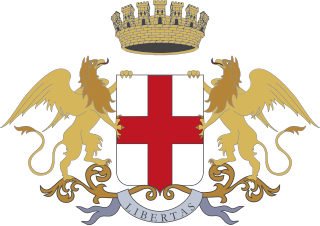
Nicolò Guarco was a Genoese statesman who became the 7th doge of the Republic of Genoa and led the Republic through the War of Chioggia against Venice.

The Raid on Genoa was a minor naval engagement fought in the harbour of the Italian city of Genoa during the first year of the French Revolutionary Wars. French Republican forces in the Mediterranean, under pressure from Austrian and Spanish armies, Royalist uprisings and British blockade had suffered the loss of their principal naval base and the fleet stationed there when British forces under Lord Hood seized Toulon at the invitation of the city's Royalist faction. The survivors of the French fleet were scattered across the Mediterranean, several sheltering in neutral Italian harbours, including the frigates Modeste at Genoa and Impérieuse at Leghorn.

Genoa is a city in and the capital of the Italian region of Liguria, and the sixth-largest city in Italy. In 2023, 558,745 people lived within the city's administrative limits. While its metropolitan city has 813,626 inhabitants, more than 1.5 million people live in the wider metropolitan area stretching along the Italian Riviera.

The Genoese navy was the naval contingent of the Republic of Genoa's military. From the 11th century onward the Genoese navy protected the interests of the republic and projected its power throughout the Mediterranean and Black Seas. It played a crucial role in the history of the republic as a thalassocracy and a maritime trading power.

Prospero Adorno was the 34th Doge of the Republic of Genoa. Between 1477 and 1478 he was appointed Genoese governor for Gian Galeazzo Maria Sforza, after the submission of the Republic to the House of Sforza, Dukes of Milan.

Francesco Maria Imperiale Lercari was the 127th Doge of the Republic of Genoa and king of Corsica.
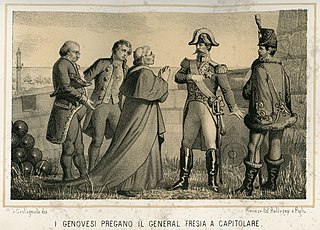
The siege of Genoa on 13–18 April 1814 was the capture of the port city of Genoa from the First French Empire by a British–Sicilian army. It was the last battle of the War of the Sixth Coalition's Italian campaign, as on 4 April, Napoleon had abdicated as emperor of France.




















